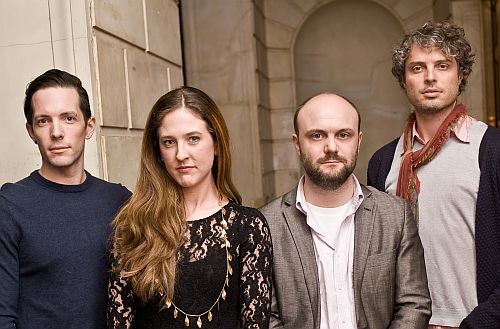 United States MATA Interval 7.2, Moby Dick: Extracts on Death and Other Curiosities: West Fourth New Music Collective, ISSUE Project Room, New York City. 21.2.2014 (DS)
United States MATA Interval 7.2, Moby Dick: Extracts on Death and Other Curiosities: West Fourth New Music Collective, ISSUE Project Room, New York City. 21.2.2014 (DS)

Matt Frey
Tim Hansen
Molly Herron
Ruben Naeff
Contemporaneous
David Bloom, conductor
Last weekend at Brooklyn’s ISSUE Project Room, I stumbled upon a musical Cliffs Notes version of the Great American Novel, Moby Dick. Dubbed “Interval 7.2,” MATA united four young composers and the new music ensemble Contemporaneous to create a collaborative concert-length oratorio, Moby Dick: Extracts on Death and Other Curiosities, about this novel of obsession, identity, and the existence of God. This was no small feat (be it to catch an elusive whale or to write a collaborative hour-length piece). But Tim Hansen, Molly Herron, Ruben Naeff, and Matt Frey of West Fourth New Music Collective composed individual movements in their respective styles that came together in a strong, holistic way that fit together like the flexible interlocking vertebrae of Melville’s square-headed whale.
Hansen began the work with the movement called “Hymn,” which set the tone for the darkly adventurous aspects of this seafaring exploit. His concept struck a superbly eerie chord (literally) as the atonal rumblings of the ensemble—a tidal wave of power and noise—gradually engulfed the crystal-clear male vocal folksong that hovered over top. The repetitive phrase “in black distress” (from the book’s Chapter 9) further drove in the point of noir foreboding.
There was no chronological narrative to the movements, but each composer chose selections from the novel to evoke differing themes or infamous sections, which all came together into an original invention. Thus, the famous opening line “Call me Ishmael,” did not appear until the last movement, “Call Me,” by Molly Herron. A beautiful collusion between the strings and voice twirled together all the famous names from the novel, which if you loved this book or even just had to read it once, drove a nostalgic stake right through the heart. Queequeg, Starbuck (yup, the coffee company came later), Ahab, Tashtego, and Pip were just a few which flew like the wind through the movement, until a booming “Ishmael” fell upon the singers’ tongues.
The entire twelve movements demonstrated a consistent momentum with an appropriate stormy swell in length just at the middle (and longest) sixth movement, Ruben Naeff’s “The Non-Valvular Structure of the Whale’s Blood Vessels.” Naeff captured the symbolism of the novel that blends with the obsessively qualified scientific details, which weigh heavy in many chapters. “Bleeding and bleeding” (from Chapter 81) is emotionally bellowed by the singers while the imagery of bones, cartilage and pulsing blood are suitably evoked by organic-sounding lines emerging from piano, marimba, and percussion.
Another triumph of this oratorio is that while it held together in one great Pequod-like structure (in case you had forgotten, Pequod is the name of the ship), each movement could easily stand alone, gracing future performances. Matt Frey’s “A White and Turbid Wake” wonderfully combined minimalist style with a lyrical American ballad quality that I’d be eager to hear again.
By bringing together these four artists, one might call this Moby Dick an exquisitely curated work more than just “a piece.” The performance, led by David Bloom, was both well-matched to the book and with a thoughtful narrative line revealed by the re-ordering of individual movements. I had expected more quirkiness or irony to emerge, as it does in Melville’s words, but it made this interpretation no less compelling and powerful. Ultimately, a great satisfaction emerges, not only from the obvious entertainment factor, but from watching one great artwork father the creation of another.
Daniele Sahr